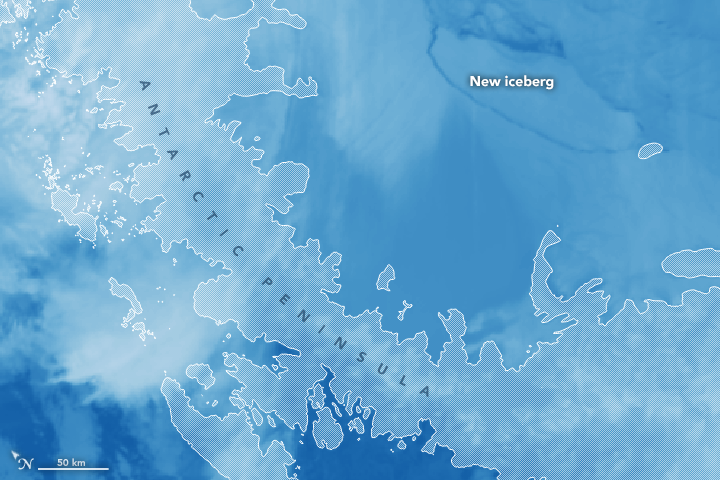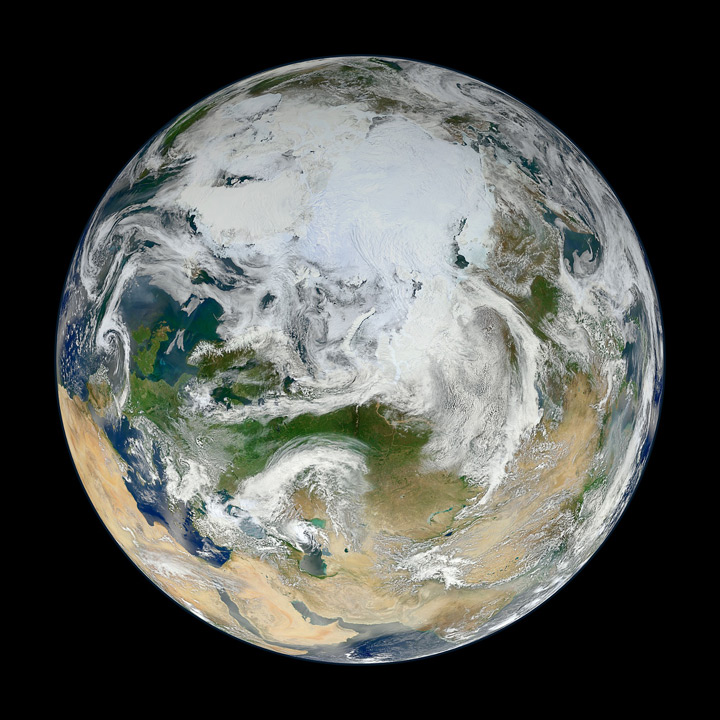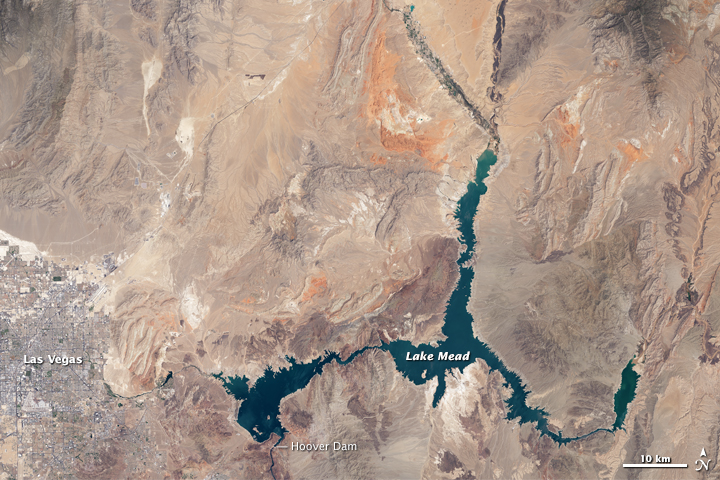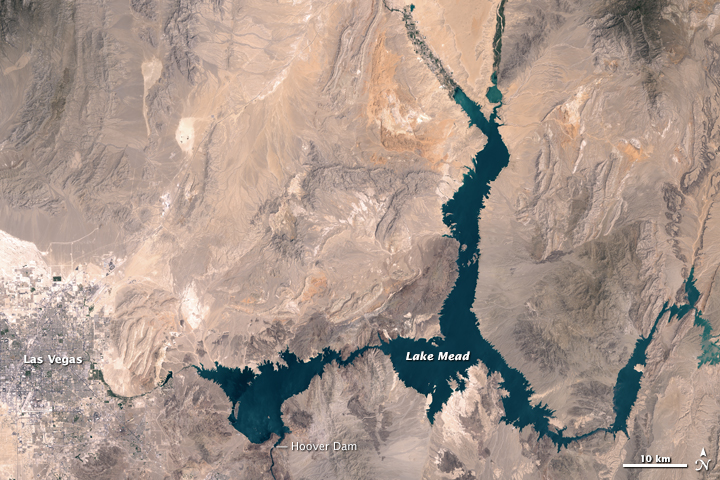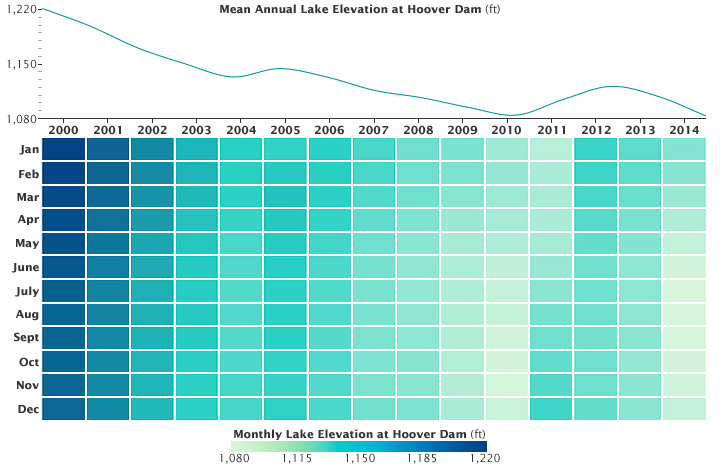Archive for the ‘Climate Change’ Category
NASA: Sometime between July 10 and July 12, an iceberg about the size of Delaware split off from Antarctica’s Larsen C ice shelf.
Thursday, July 13th, 2017Sometime between July 10 and July 12, an iceberg about the size of Delaware split off from Antarctica’s Larsen C ice shelf. Now that nearly 5,800 square kilometers (2,200 square miles) of ice has broken away, the Larsen C shelf area has shrunk by approximately 10 percent.
Scientists have been tracking the stability of this ice shelf for several years. The Moderate Resolution Imaging Spectroradiometer (MODIS) on NASA’s Aqua satellite captured an image (above) of the new iceberg on July 12, 2017. The false-color view uses MODIS band 31, which measures infrared signals known as “brightness temperature.” This measurement is useful for distinguishing the relative warmth or coolness of a landscape. Dark blue depicts where the surface is the warmest—most notably between the new iceberg and the ice shelf, but also in areas of open ocean or where water is topped by thin sea ice. Lighter blue colors show intact or thicker ice (cooler surfaces).
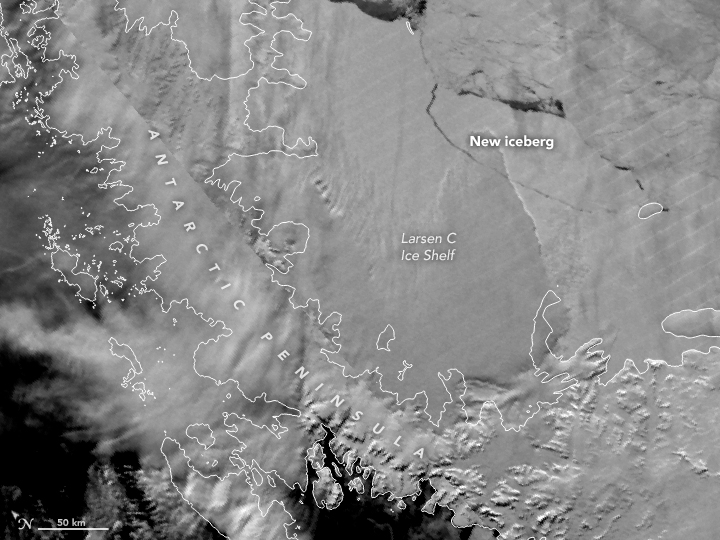
The calving event was confirmed by the Visible Infrared Imaging Radiometer Suite (VIIRS) on the Suomi NPP satellite. The day-night band (DNB) of VIIRS captured this image on July 12, 2017.
The final rupture was first reported by Project MIDAS, an Antarctic research project based in the United Kingdom. Adrian Luckman of Swansea University and MIDAS explains the significance of the calving event in a post here.
Larsen C, a floating platform of glacial ice on the east side of the Antarctic Peninsula, is the fourth-largest ice shelf on the coast of Antarctica. In 2014, a crack that had been slowly growing in the ice shelf for decades suddenly turned northward and accelerated, creating today’s iceberg.
“The interesting thing is what happens next…how the remaining ice shelf responds,” said Kelly Brunt, a glaciologist from NASA’s Goddard Space Flight Center and the University of Maryland. “Will the ice shelf weaken, or possibly collapse like its neighbors Larsen A and B? Will the glaciers behind the ice shelf accelerate and have a direct contribution to sea level rise? Or is this just a normal calving event?”
Scientists have monitored the progression of the rift over the past year using data from the European Space Agency’s Sentinel satellites (which can image with radar during the long Antarctic night) and thermal imagery from Landsat 8 and the MODIS instruments on NASA’s Terra and Aqua satellites.
In the coming months and years, researchers will monitor the response of Larsen C and the glaciers that flow into it with satellite imagery, airborne surveys, automated geophysical instruments on the ice, and field work.
“We don’t currently know what changed in 2014 that allowed this rift to push through the suture zone and propagate into the main body of the ice shelf,” said Dan McGrath, a glaciologist at Colorado State University who has been studying Larsen C since 2008.
McGrath said the growth of the crack is not directly linked to climate change. “The Antarctic Peninsula has been one of the fastest warming places on the planet throughout the latter half of the 20th century. This warming has driven really profound environmental changes, including the collapse of Larsen A and B,” McGrath said. “But with the rift on Larsen C, we haven’t made a direct connection with the warming climate. Still, there are definitely mechanisms by which this rift could be linked to climate change, most notably through warmer ocean waters eating away at the base of the shelf.”
The U.S. National Ice Center will monitor the trajectory of the new iceberg, which is likely to be named A-68. The currents around Antarctica generally dictate the path that the icebergs follow. In this case, the new berg is likely to follow a similar path to the icebergs produced by the collapse of Larsen B: north along the coast of the peninsula, then northeast into the South Atlantic.
-
References and Related Reading
- NASA Earth Observatory (2017, June 29) A Crack of Light in the Polar Dark.
- NASA Ice (2017, July 12) Massive Iceberg Breaks Off from Antarctica. Accessed July 12, 2017.
- Project MIDAS (2017, July 12) Larsen C calves trillion ton iceberg. Accessed July 12, 2017.
NASA Earth Observatory images by Joshua Stevens, using MODIS and VIIRS data from LANCE/EOSDIS Rapid Response. Story by Maria-Jose Viñas, adapted for Earth Observatory by Kathryn Hansen.
- Instrument(s):
- Aqua – MODIS
- Suomi NPP – VIIRS
A chunk of floating ice that weighs more than a trillion metric tons broke away from the Antarctic Peninsula
Wednesday, July 12th, 2017https://www.youtube.com/watch?v=hKRz8CTtVvk
CDC: Building Resilience Against Climate Effects (BRACE) Framework
Monday, January 9th, 2017
The Building Resilience Against Climate Effects (BRACE) framework is a five-step process that allows health officials to develop strategies and programs to help communities prepare for the health effects of climate change. Part of this effort involves incorporating complex atmospheric data and both short and long range climate projections into public health planning and response activities. Combining atmospheric data and projections with epidemiologic analysis allows health officials to more effectively anticipate, prepare for, and respond to a range of climate sensitive health impacts.
Five sequential steps comprise the BRACE framework:
Step 1: Anticipate Climate Impacts and Assessing Vulnerabilities
Identify the scope of climate impacts, associated potential health outcomes, and populations and locations vulnerable to these health impacts.
Assessing health vulnerability to climate change: A guide for health departments[PDF – 4.35 MB]
Step 2: Project the Disease Burden
Estimate or quantify the additional burden of health outcomes associated with climate change.
Step 3: Assess Public Health Interventions
Identify the most suitable health interventions for the identified health impacts of greatest concern.
Step 4: Develop and Implement a Climate and Health Adaptation Plan
Develop a written adaptation plan that is regularly updated. Disseminate and oversee implementation of the plan.
Step 5: Evaluate Impact and Improve Quality of Activities
Evaluate the process. Determine the value of information attained and activities undertaken.
More in-depth information about the BRACE framework can be found in the document titled Building Resilience against Climate Effects—A Novel Framework to Facilitate Climate Readiness in Public Health Agencies.
The Paris Agreement, which seeks to limit global warming to 2 degrees C (3.6 degrees F), thereby combatting climate change becomes international law today
Friday, November 4th, 2016- “….But scientists and policy makers say the agreement entering into force is just the first step of a much longer and complicated process of transitioning away from fossil fuels, which currently supply the bulk of the planet’s energy needs and also are the primary drivers of global warming….”
- “….While the Paris agreement is legally binding, the emissions reductions that each country has committed to are not. Instead, the agreement seeks to create a transparent system that will allow the public to monitor how well each country is doing at meeting its goals in hopes that this will motivate them to transition more quickly to clean, renewable energy like wind, solar and hydropower….”
- “….A report by the U.N. Environment Program released Thursday projects that annual emissions must be kept below 42 billion tons of CO2 (carbon dioxide) by 2030 for the world to have a chance to meet the goals set out in the Paris agreement. However, the agreement itself foresees emissions reaching 54 billion-56 billion tons in 2030, setting the world on a course to exceed the goal of limiting warming to 2 degrees Celsius (3.6 degrees Fahrenheit)…..”



